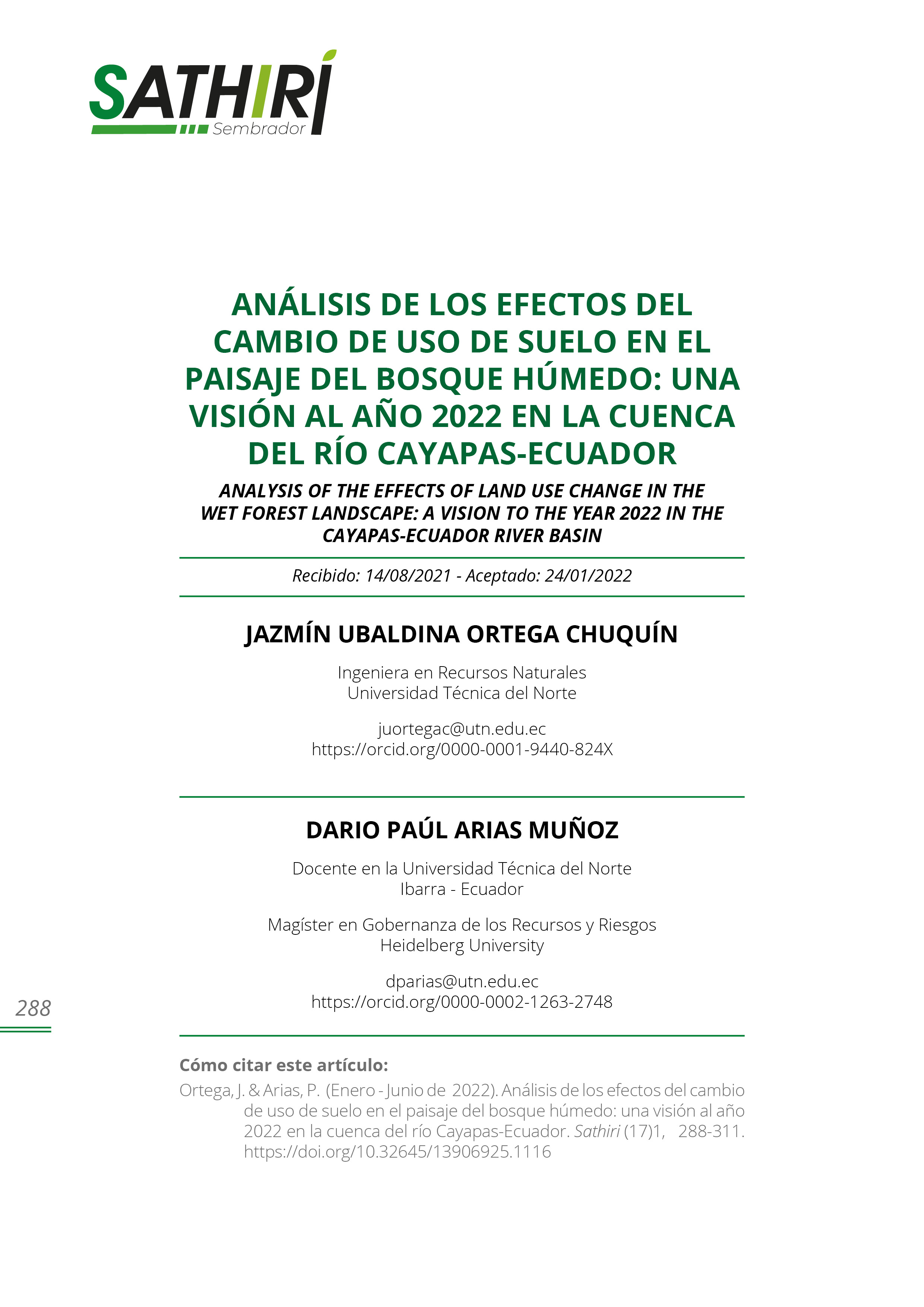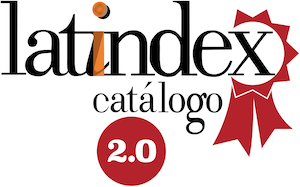Analysis of the effects of land use change in the wet forest landscape: a vision to the year 2022 in the Cayapas-Ecuador river basin
DOI:
https://doi.org/10.32645/13906925.1116Keywords:
hotspot, fragmentation, land-use change, humid forest, critically endangeredAbstract
The humid forest is an ecosystem that is categorized in critical danger as a result of the increase in the expansion of the agricultural frontier. In this study, the effects of land use change in the humid forest landscape were analyzed: in the Tumbes - Chocó - Magdalena hotspot, in the Cayapas river basin in 1982, 2002 and a projected future in 2022. For this, the land use was projected to the year 2022 by using the TERRSET software and the land use coverage of the year 1982 and 2002 was used as base information. The effects on the landscape were evaluated by obtaining the landscape indices. such as: total area, index of the largest patch, number of patches, border density. The results show that the native forest registered a loss of 27.53% between the 1982-2002 period and for the year 2022 it presented a natural regeneration of 2.7%. The immediate effect of this transition in the humid forest was fragmentation due to the increase in the number of patches from 3 to 1276 between the period 1982 - 2022. Consequently, the native forest patches are far away from each other, which Problems connectivity and the different ecological processes that take place in this type of ecosystem
References
Bergamin, R., Debastiani, V., Joner, D., Lemes, P., Guimarães, T., Loyola, R., Müller, S. (2019). Loss of suitable climatic areas for Araucaria forests over time. Plant Ecol. Divers, 12, 115-126. 10.1080/17550874.2019.1618408
Brown, J., Paz, A., Reginato, M., Renata, C., Assis, C., Lyra, M., Caddah, M., Aguirre-Santoro, J., d'Horta, F., Raposo do Amaral, F., Goldenberg, R., Silva-Brandão, K., Freitas, A., Rodrigues, M., Michelangeli, F., Miyaki, C., Carnaval, A. (2020). Seeing the forest through many trees: multi-taxon patterns of phylogenetic diversity in the Atlantic Forest hotspot. Divers. Distrib, 26, 1160-1176. 10.1111/ddi.13116
Conservación Internacional. (2014). Chocó Ecuatoriano conservación internacional. https://conservation.org.ec/choco-ecuatoriano/
Correa, C. A., Mendoza, M., y López, E. (2014). Análisis del cambio en la conectividad estructural del paisaje (1975-2008) de la cuenca del lago Cuitzeo, Michoacán, México. Revista de geografía Norte Grande, 59, 7-23. https://www.redalyc.org/articulo.oa?id=30032725002
Chuvieco, E. (2008). Teledetección ambiental la observación de la tierra desde el espacio. Ariel, S.A. España. https://go.gale.com/ps/i.do?p=IFME&u=anon~67dcf30c&id=GALE|A242180195&v=2.1&it=r&sid=googleScholar&asid=14067072
De Palma, A., Hoskins, A., Gonzalez, RE., Börger, L., Newbold, T., Sanchez-Ortiz, K., Ferrier, S., Purvis, A. (2019). Annual changes in the Biodiversity Intactness Index in tropical and subtropical forest biomes, 2001-2012. bioRxiv, 311688. https://doi.org/10.1101/311688
Echeverría, C., Bolados, G., Rodríguez, J., Aguayo, M., y Premoli, A. (2014). Ecología Forestal. Bases Para El Manejo Forestal Sustentable y Conservación de Los Bosques Nativos de Chile. Ediciones Universidad Austral de Chile.
Espinosa, C., De la Cruz, M., y Escudero, A. (2012). Bosques tropicales secos de la región Ecuatorial: diversidad, estructura, funcionamiento e implicaciones para la conservación. Ecosistemas, 21(1-2), 167-179. https://www.redalyc.org/articulo.oa?id=54026849013
Etemadi, H., Smoak, J.M., Karami, J. (2018). Land use change assessment in coastal mangrove forests of Iran utilizing satellite imagery and CA–Markov algorithms to monitor and predict future change. Environ. Earth Sci, 77. 10.1007/s12665-018-7392-8
FAO and UNEP. (2020). The State of the World's Forests 2020. Forests, Biodiversity and People. Rome. 10.4060/ca8642en
Ferrer, J.R., Zager, I., Keith, D.A., Oliviera, M., Rodríguez, J.P., Josse, C., Gonzáles, M., Miller, R., Zambrana, C., y Barrow, E. (2019). An ecosystem risk assessment of temperate and tropical forests of the Americas with an outlook on future conservation strategies. Conservation Letter, 12(15). https://doi.org/10.1111/conl.12623
Gashaw, T., Tulu, T., Argaw, M., Worqlul, A.W. (2018). Modeling the hydrological impacts of land use/land cover changes in the Andassa watershed, Blue Nile Basin, Ethiopia. Sci. Total Environ, 619, 1394-1408. 10.1016/j.scitotenv.2017.11.191
Government of Kenya. (2018). Task-force-report on Forest Resources Management and Logging Activities in Kenya.
INPE. (2020). Monitoramento da Floresta Amazônica Brasileira Por Satélite Projeto Prodes. http://www.obt.inpe.br/prodes
Instituto Nacional de Estadísticas y Censos de Ecuador (INEC). (1982). IV Censo Nacional de Población 1982. Ecuador. https://www.ecuadorencifras.gob.ec/documentos/web-inec/Bibliotecas/Libros/Libros_Censos/17.%20IV_Censo_de_Pobl_1982_Resumen_Nac.pdf
Instituto Nacional de Estadísticas y Censos de Ecuador (INEC). (2001). Resultados del Censo 2001 de población y vivienda en el Ecuador. https://biblio.flacsoandes.edu.ec/catalog/resGet.php?resId=14251
Instituto Nacional de Estadísticas y Censos de Ecuador (INEC). (2019). Población demográfica: resultados provinciales. https://www.ecuadorencifras.gob.ec/censo-de-poblacion-y-vivienda/
Landis, J. R., y Koch, G. (1977). Thue Measurement of Observer Agreement for Categorical Data. Biometrics, 33(1), 159-174. http://dx.doi.org/10.2307/2529310
López, M., Gonzáles, J., Díaz, S., Castro, I., y García, M. (2007). Biodiversidad y bienestar humano: el papel de la diversidad funcional. Ecosistemas, 16 (3), 68-79. http://hdl.handle.net/10045/7648
Lutz, J., Furniss, T., Johnson, D., Davies, S., Allen, D., Alonso, A., Anderson, K., Andrade, A., Baltzer, J., Becker, K., Blomdahl, E., Bourg, N., Bunyavejchewin, S., Burslem, D., Cansler, C., Cao, K., Cao, M., Cárdenas, D., Chang, L., Chao, K., Chao, W., Chiang, J., Chu, C., Chuyong, G., Clay, K., Condit, R., Cordell, S., Dattaraja, H., Duque, A., Ewango, C., Fischer, G., Fletcher, C., Freund, J., Giardina, C., Germain, S., Gilbert, G., Hao, Z., Hart, T., Hau, B., He, F., Hector, A., Howe, R., Hsieh, C., Hu, Y., Hubbell, S., Inman, F., Itoh, A., Janík, D., Kassim, A., Kenfack, D., Korte, L., Král, K., Larson, A., De Li, Y., Lin, Y., Liu, S., Lum, S., Ma, K., Makana, J., Malhi, Y., McMahon, S., McShea, W., Memiaghe, H., Mi, X., Morecroft, M., Musili, P., Myers, J., Novotny, V., De Oliveira, A., Ong, P., Orwig, D., Ostertag, R., Parker, G., Patankar, R., Phillips, R., Reynolds, G., Sack, L., Song, G., Su, S., Sukumar, R., Sun, I., Suresh, H., Swanson,Y., Tan, S., Thomas, D., Thompson, J., Uriarte, M., Valencia, R., Vicentini, A., Vrška, T., Wang, X., Weiblen, G., Wolf, A., Wu, S., Xu, H., Yamakura, T., Yap, S., Zimmerman, J. (2018). Global importance of large-diameter trees. Glob. Ecol. Biogeogr, 27, 849-864. 10.1111/geb.12747
Kauppi, P.E., Sandström, V., Lipponen, A. (2018). Forest resources of nations in relation to human well-being. PLoS One, 13 (5), 1-10. https://doi.org/10.1371/journal.pone.0196248
Márquez, G. (2002). Estado de los recursos naturales y del Ambiente 2001 – 2002: Políticas sectoriales, bosques y participación ciudadana. Nacional de Colombia. https://biblio.flacsoandes.edu.ec/catalog/resGet.php?resId=16382
Mansour, S., Al-Belushi, M., Al-Awadhi, T. (2020). Monitoring land use and land cover changes in the mountainous cities of Oman using GIS and CA-Markov modelling techniques. Land Use Policy, 91. 10.1016/j.landusepol.2019.104414
McGarigal, K., Cushman, S. y Ene, E. (2012). FRAGSTATS v4: Programa de análisis de patrones espaciales para mapas categóricos y continuos. Universidad de Massachusetts, Amherst.
Mogrovejo, P. (2017). Bosques y cambio climático en Ecuador: el regente forestal como actor clave en la mitigación del cambio climático [Tesis de maestría, Universidad Andina Simón Bolívar]. Quito, Ecuador. http://hdl.handle.net/10644/5862
Momirović, N., Kadović, R., Perović, V., Marjanović, M., Baumgertel, A. (2019). Spatial assessment of the areas sensitive to degradation in the rural area of the municipality Čukarica. Int. Soil Water Conserv. Res, 7 (1), 71-80. 10.1016/j.iswcr.2018.12.004
Muhati, G. L., Olago, D., Olaka, L. (2018). Participatory scenario development process in addressing potential impacts of anthropogenic activities on the ecosystem services of MT. Marsabit Forest, Kenya. Global Ecology and Conservation, 14. https://doi.org/10.1016/j.gecco.2018.e00402
Muhati, G. L., Olago, D., Olaka, L. (2018). Land use and land cover changes in a sub-humid Montane Forest in an arid setting: A case study of the Marsabit forest reserve in northern Kenya. Global Ecology and Conservation, 16. https://doi.org/10.1016/j.gecco.2018.e00512
Noblecilla, M. (2020). Efectos de la pérdida de bosque sobre los roedores cricétidos en Carpish, Huánuco, Perú. Revista peruana de biología, 27(4), 499 - 508. http://dx.doi.org/10.15381/rpb.v27i4.17211
Nóbrega, R., Guzha, A.C., Lamparter, G., Amorim, R., Couto, E.G., Hughes, H.J., Jungkunst, H.F., Gerold, G. (2018). Impacts of land-use and land-cover change on stream hydrochemistry in the Cerrado and Amazon biomes. Sci. Total Environ, 635, 259-274. 10.1016/j.scitotenv.2018.03.356
Otavo, S., y Echeverría, C. (2017). Fragmentación progresiva y pérdida de hábitat de bosques naturales en uno de los hotspot mundiales de biodiversidad. Revista Mexicana de Biodiversidad, 88(4), 924-935. https://doi.org/10.1016/j.rmb.2017.10.041
Paegelow, M., Camacho, M., y Menor-Toribio, J. (2003). Cadenas de Markov, evaluación multicriterio y evaluación multiobjetivo para la modelización prospectiva del paisaje. GeoFocus. Revista Internacional de Ciencia y Tecnología de la Información Geográfica (GeoFocus), 3(1), 22-44. http://www.geofocus.org/index.php/geofocus/article/view/21
Palahí, M., Valbuena, R., Senf, C., Acil, N., Pugh, T.A., Sadler, J., Seidl, R., Potapov, P., Gardiner, B., Hetemäki, L. (2021). Concerns about reported harvests in European forests. Nature, 592, 15-17.
Palmate, S., Pandey, A., Mishra, SK. (2017). Modelling spatiotemporal land dynamics for a trans-boundary river basin using integrated Cellular Automata and Markov Chain approach. Apl. Geogr, 82, 11 – 23. 10.1016/j.apgeog.2017.03.001
Pandey, B.K., y Khare, D. (2017). Analyzing and modeling of a large river basin dynamics applying integrated cellular automata and Markov model. Environ. Earth Sci, 76, 1-12. 10.1007/s12665-017-7133-4
Perović, V., Kadović, R., Đurđevi, V., Pavlović., D., Pavlović, M., Čakmak, D., Mitrović, M., Pavlović, P. (2021). Major drivers of land degradation risk in Western Serbia: Current trends and future scenarios. Ecological Indicators, 123. https://doi.org/10.1016/j.ecolind.2021.107377
PNUMA. (2015). Programa de las Naciones Unidas para el Medio Ambiente. www.pnuma.org/recnat/esp/diversiadad-biologica.php
Ramos Reyes, R., Palomeque de la Cruz, M., Núñez, J., y Sánchez Hernández, R. (2019). Análisis geomático espacial del cambio de uso del suelo en Huimanguillo, Tabasco (2000-2010-2030). Revista mexicana de ciencias forestales, 10(53), 118-139. https://doi.org/10.29298/rmcf.v10i53.555
Rodrigues da Cunha, E., Guimarães Santos, C., Marques da Silva, R., Bacani, V., y Pott, A. (2021). Future scenarios based on a CA-Markov land use and land cover simulation model for a tropical humid basin in the Cerrado/Atlantic Forest ecotone of Brazil. Land Use Policy, 101. https://doi.org/10.1016/j.landusepol.2020.105141
Rojas, N., Barboza Castillo, E., Maicelo Quintana, J., Oliva Cruz, S., y Salas López, R. (2019). Deforestación en la Amazonía peruana: Índices de cambios de cobertura y uso del suelo basado en SIG. Boletín de la Asociación de Geógrafos Españoles, 81. https://doi.org/10.21138/bage.2538a
Rojas, E. (2017). Análisis y simulación para el año 2030 de los bosques húmedos amazónicos de Perú para el cambio climático [Tesis de maestría, Universidad de Barcelona]. Barcelona, España. http://hdl.handle.net/2445/118801
Saatchi, S., Longo, M., Xu, L., Yang, Y., Abe, H., André, M., Aukema, J., Carvalhais, N., Cadillo-Quiroz, H., Ann Cerbu, G., M. Chernela, J., Covey, K., Sánchez- Clavijo, L., Cubillos, I., Davies, S., De Sy, V., De Vleeschouwer, F., Elmore, A. (2021). Detecting vulnerability of humid tropical forests to multiple stressors. One Earth. 4(7), 988-1003. https://doi.org/10.1016/j.oneear.2021.06.002
Santos, CAG., Do Nascimento, TVM., y Silva, RM. (2020). Analysis of forest cover changes and trends in the Brazilian semiarid region between 2000 and 2018. Environ Earth Sci, 79, 418-438. https://doi.org/10.1007/s12665-020-09158-1
Salunkhe, S., Bera, A., Rao, S., Venkataraman, V., Raj, U., Murthy, Y. (2018). Evaluation of indicators for desertification risk assessment in part of Thar Desert Region of Rajasthan using geospatial techniques. J. Earth Syst. Sci, 127, 116. 10.1007/s12040-018-1016-2
Sierra, R. (1996). La deforestación en el noroccidente del Ecuador 1983-1993. EcoCiencia. https://www.scielo.br/scielo.php?script=sci_nlinks&ref=000213&pid=S0031-1049201100010000100054&lng=en
Siqueira, J., Sonter, L., y Sánchez, L. (2020). Exploring potential impacts of mining on forest loss and fragmentation within a biodiverse region of Brazil's northeastern Amazon. Resources Policy, 67. https://doi.org/10.1016/j.resourpol.2020.101662
Sistema Nacional de Información. (2014). Archivos de información geográfica. https://sni.gob.ec/coberturas
Song, XP., Hansen, MC., Stehman, SV., Potapov, PV., Tyukavina, A., Vermote, EF., Townshend, JR. (2018). Global land change from 1982 to 2016. Nature, 560, 639 – 643. 10.1038 / s41586-018-0411-9
Tejedor, N., Álvarez, E., Arango, S., Araujo, A., Blundo, C., Boza, T.E., La Torre Cuadros, M., Gavaria, J., Gutiérrez, N., Jorgensen, P., León, B., López, R., Malizia, L., Millán, B., Moraes, M., Pacheco, S., Rey Benayas, J., Reynel, C., Timaná de la Flor, M., Ulloa Ulloa, C., Vacas, O., Newton, A. (2012). Evaluación del estado de conservación de los bosques montanos en los Andes Tropicales. Ecosistemas, 21(1-2), 148-166. https://www.revistaecosistemas.net/index.php/ecosistemas/article/view/34
Torrachi, J. (2015). Deforestación y pérdida de hábitat en bosques de montaña en la cuenca alta del río Zamora, Loja – Ecuador [Tesis de doctorado, Universidad Politécnica de Madrid]. Madrid, España. http://oa.upm.es/39446/1/JOSE_ESTEBAN_TORRACCHI_CARRASCO.pdf
Torres, N., y Vivanco, V. (2018). Comparación en la estimación de material particulado PM10 usando imágenes satelitales Lansat 7, Landsat 8 y Modis en Quito [Tesis de grado, Universidad Politécnica Salesiana]. Quito, Ecuador. https://dspace.ups.edu.ec/handle/123456789/16071
Tucker, C., y Townshend, J. (2000). Strategies for monitoring tropical deforestation using satellite data. International Journal of Remote Sensing, 21(6-7), 1461–1471. https://doi.org/10.1080/014311600210263
Valero, J. (2015). Estudio multitemporal y análisis prospectivo del cambio de uso de suelo y cobertura vegetal en la microcuenca de río Cristal mediante el uso de autómatas celulares [Tesis de grado, Universidad de las Fuerzas Armadas]. Quito, Ecuador. http://repositorio.espe.edu.ec/handle/21000/9498
Vancutsem, C., Achard, F., Pekel, J.-F., Vieilledent, G., Carboni, S., Simonetti, D., Gallego, J., Aragão, L., Nasi, R. (2021). Long-term (1990–2019) monitoring of forest cover changes in the humid tropics. Sci. Adv, 7.
Varea, A. (2004). Iniciativas para conservar la biodiversidad. Universitas: Revista de Ciencias Sociales y Humanas, 4. http://dx.doi.org/10.17163/uni.n4.2004.01
Velásquez, E. (2014). La Biodiversidad en el Ecuador. Universitaria Abya-Yala Cuenca, Ecuador. https://dspace.ups.edu.ec/handle/123456789/6788
Vié, J., Hilton-Taylor, C., Stuart, S. (2009). Wildlife in a changing world: an analysis of the 2008 IUCN Red List of threatened species. UICN, Gland, Suiza. https://www.academia.edu/1222645/Wildlife_in_a_changing_world_an_analysis_of_the_2008_IUCN_Red_List_of_threatened_species
Vijith, H., Hurmain, A., y Dodge-Wan, D. (2018). Impacts of land use changes and land cover alteration on soil erosion rates and vulnerability of tropical mountain ranges in Borneo, Remote Sensing Applications: Society and Environment, 12, 57-69. https://doi.org/10.1016/j.rsase.2018.09.003
Wernick, I.K., Ciais, P., Fridman, J., Högberg, P., Korhonen, K.T., Nordin, A., Kauppi, P.E. Quantifying Forest change in the European Union. Nature, 592, 13-14.
West, T.A., y Fearnside, P.M. (2021). Brazil’s conservation reform and the reduction of deforestation in Amazonia. Land Use Policy, 100. 10.1016/j.landusepol.2020.105072
Wilson, O., Walters, R., Mayle, F., Lingner, D., Vibrans, A. (2019). Cold spot microrefugia hold the key to survival for Brazil's Critically Endangered Araucaria tree. Global Change Biol, 25, 4339-4351. 10.1111/gcb.14755
Xu, T., Gao, J., Li, Y. (2019). Machine learning-assisted evaluation of land use policies and plans in a rapidly urbanizing district in Chongqing, China. Land Use Policy, 87. 10.1016/j.landusepol.2019.104030
Zhou, N., Hu, X., Byskov, I., Sandstad, J., Wu, Q., Zhao, W., Cherubini, F. (2021). Overview of recent land cover changes, forest harvest areas, and soil erosion trends in Nordic countries. Geography and Sustainability. 2(3), 163-174. https://doi.org/10.1016/j.geosus.2021.07.001

Downloads
Published
Issue
Section
License
Copyright (c) 2022 Jazmín Ubaldina Ortega Chuquín, Dario Paúl Arias Muñoz

This work is licensed under a Creative Commons Attribution-NonCommercial-NoDerivatives 4.0 International License.
El autor mantiene los derechos morales e intelectuales de su obra, autorizando a la editorial de la revista Sathiri la difusión y divulgación de su contenido con fines estrictamente académicos y de investigación, sin fines de lucro. Así mismo, se autoriza que la obra sea descargada y compartida con otras personas, siempre y cuando no sea alterada y se reconozca su autoria.





















